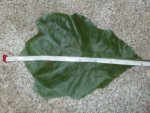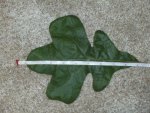oldfella1962
Senior Member
okay - I have seen thousands of post oak/blackjack oaks/water oaks where I hunt. Yes I'm a traditional bowhunter so I move like a turtle and exam every square inch of everything in eyesight - and I am a tree geek. That said according to my book "National Audubon Society Field Guide to North American Trees - Eastern Region" these leaves should not exist! First up is either a blackjack oak or a water oak, but regardless - neither of these trees has a leaf eight inches long! BTW of all the hundreds of acres I hunt, the trees producing these mutant leaves grow in one tiny area. Next up is a post oak ( I think) with a leaf nine inches long! Again, in this same tiny area. According to the book, blackjack oaks are 2-1/2 to 5 inches. The second leaf post oak should be between 3-1/4 and 6 inches. Regardless no oak tree growing around here should have leaves that big. Any thoughts?


